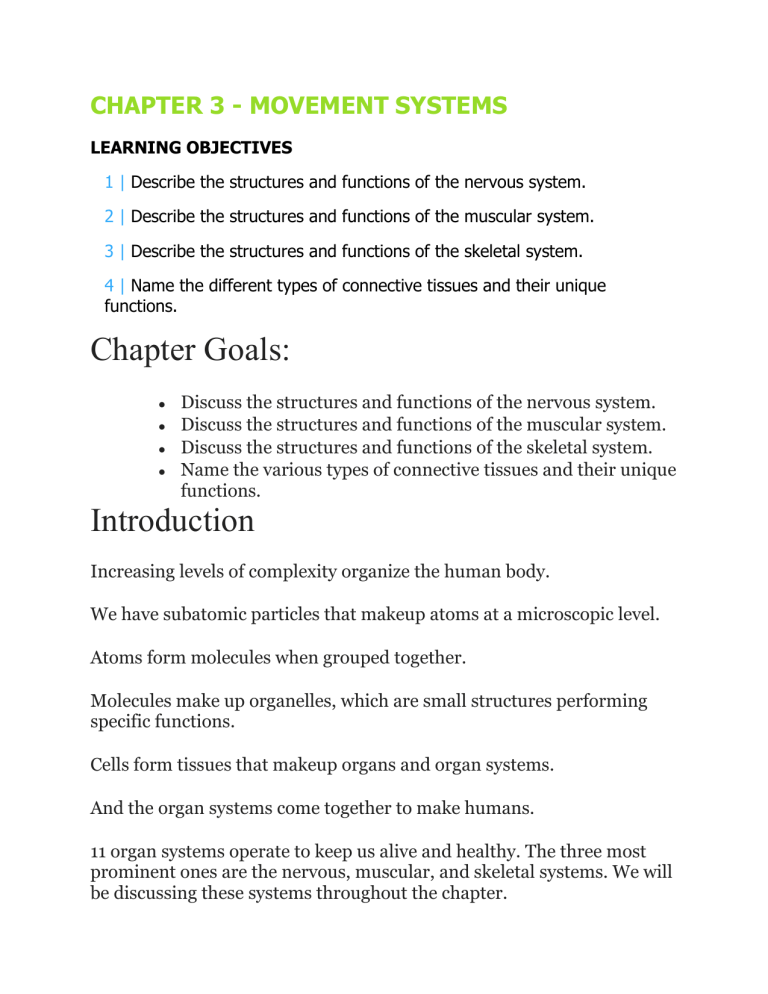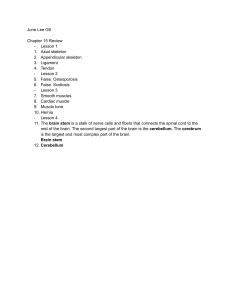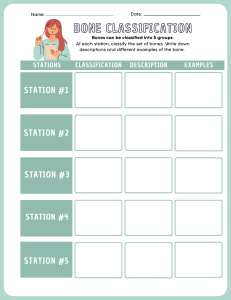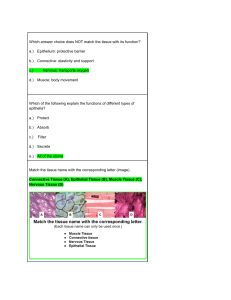
CHAPTER 3 - MOVEMENT SYSTEMS LEARNING OBJECTIVES 1 | Describe the structures and functions of the nervous system. 2 | Describe the structures and functions of the muscular system. 3 | Describe the structures and functions of the skeletal system. 4 | Name the different types of connective tissues and their unique functions. Chapter Goals: ● ● ● ● Discuss the structures and functions of the nervous system. Discuss the structures and functions of the muscular system. Discuss the structures and functions of the skeletal system. Name the various types of connective tissues and their unique functions. Introduction Increasing levels of complexity organize the human body. We have subatomic particles that makeup atoms at a microscopic level. Atoms form molecules when grouped together. Molecules make up organelles, which are small structures performing specific functions. Cells form tissues that makeup organs and organ systems. And the organ systems come together to make humans. 11 organ systems operate to keep us alive and healthy. The three most prominent ones are the nervous, muscular, and skeletal systems. We will be discussing these systems throughout the chapter. The Nervous System The nervous system is the command center of the body. The nervous system dictates all movement. Training adaptations and physical fitness can’t be well understood without some solid knowledge of the human nervous system and how it generates, propagates, and interprets neural signals. The nervous system comprises the nerves, spinal cord, and brain, which are responsible for the control of voluntary and involuntary functions of the body. Nervous tissue plays a role in the ability of us to sense, analyze, and interpret information and then respond to it. There are three types of nervous tissue. Neurons are the nervous tissue that transmits signals to and from other neurons, glands, or muscles. Neuroglia, or glial cells, are neural tissues that support, protect, and insulate neurons. Neurosecretory tissues are the neurons that translate neural signals into chemical stimuli. The three main parts of the neuron are the cell body, axon, and dendrites. The cell body is the core part of the neuron and has a nucleus and other specialized organelles aiding the nervous system. The axon is a thin tail-like structure of neurons that generates and conducts nerve impulses. Dendrites are rootlike structures that branch from the cell body to receive and process signals from the axons of other neurons. We can also categorize neurons based on three main jobs. Neurons can be sensory, motor, or interneurons. ● ● ● Sensory neurons are involved in communicating visual, auditory, and tactile info. Motor neurons initiate muscle contraction or activate the glands. Interneurons are nerve cells that connect neurons to each other. Central Nervous System The CNS is the first of two divisions of the nervous system. The other is the peripheral nervous system. The CNS receives the sensory inputs and functions so that the body can organize, analyze, and process information. It is made up of the brain and spinal cord. The Brain and Brain Stem The brain comprises the cerebrum, cerebellum, and brain stem. The cerebrum is the largest part of the brain and is at the top, and it consists of the right and left hemispheres. Its role is to receive and process sensory information and control the body. The cerebellum is the region of the brain responsible for conscious motor coordination. The brain stem is the trunk of the brain, and it is made of the medulla oblongata, pons, and midbrain that continue down to form the spinal cord. The cerebral cortex is also worth mentioning, as this is where the most neural integration occurs. The brain’s left hemisphere controls language, logical processing, science, math, and controlling the muscles on the right side. The brain’s right hemisphere is in charge of spatial perception, creativity, intuition, and controlling the muscles of the left side. The Spinal Cord The spinal cord is a nervous tissue tube extending from the brain to the bottom of the spine. This is the connection point between the brain and the body, as all nerve impulses travel through the spinal cord to and from the brain. The Peripheral Nervous System The PNS is the second division of the nervous system, and it is essentially all nervous tissue outside of the brain and spinal cord. In total, we have 12 cranial nerves extending from the brain and then 31 spinal nerves extending from the CNS to the peripheral organs and muscles. These nerves serve the two main functions of receiving sensory information and relaying motor and autonomic signals between the body, brain, and spinal cord. The PNS has afferent and efferent neurons. Afferent neurons are sensory neurons that send information, also called stimuli, from the body to the CNS. Efferent neurons will send information from the CNS to the muscles so movement can happen. The PNS has the sensory division and the motor division. The motor division divides into the somatic and autonomic nervous systems. The somatic system is a part of the nervous system in charge of controlling voluntary movement. The autonomic nervous system is part of the nervous system responsible for involuntary functions and movement. Functions of the Central Nervous System Sensory Impulses Millions of sensory receptors in the body perceive and communicate stimuli without stopping. Internal stimuli are changes that happen inside the body, like temperature or pH. External stimuli are messages from outside the body due to the environment, light, or sound. Sensory input receptors are called mechanoreceptors. The three types of mechanoreceptors are tactile receptors, proprioceptors, and baroreceptors. Integration of Sensory Input The input collected by all of the receptors is translated into nerve impulses or electrical signals. The brain interprets these impulses to perceive sensations, have thoughts, or form memories. Motor function Motor functions include both voluntary and involuntary muscle contractions. These contractions occur due to the firing of a motor unit. Motor units are the single motor neurons and the muscle fibers it controls. Motor unit pools are groups of motor units that work together. To turn an electrical impulse into a mechanical response, there needs to be a process known as excitation-contraction coupling. Nerve impulses sent to skeletal muscle fibers are called action potentials. The all-or-none principle states that a neural electrical signal’s strength is independent of the stimulus’s magnitude so long as the neural threshold is achieved. The Muscular System There are over 600 muscles within the body that contribute to locomotion. These muscles can pull via contraction and will be found in pairs or groups to allow for the dynamic movement that humans are capable of. Types of Muscle Tissue We have three types of muscle tissue. These are skeletal, smooth, and cardiac muscles. They will vary in function, location, and cellular structure. Skeletal muscle is the most common type of muscle in the body. These muscles are striated and voluntary. They attach to bones via tendons and are found intrinsically in the eyeballs and the upper third part of the esophagus. Smooth muscle is found within certain organs and organ systems in the body, and here, it is used to push food and other substances throughout the body. These muscles will contract slowly, operate involuntarily, and not fatigue quickly. Hormones, neural signals from the ANS, and local factors trigger smooth muscle contraction. Cardiac muscle tissue is striated and involuntary. It primarily makes up just the wall of the heart. The cardiac muscle functions to contract the heart and pump blood throughout the body. Cardiac muscle cells will often branch and fuse into one another. Cardiac muscle does not fatigue very easily, and the rest period between contractions is all it really ever needs. Structure of Skeletal Muscle Skeletal muscle allows a person to move, exercise, and perform ADL or activities of daily living. Skeletal muscle is going to consist of muscle tissue, connective tissue, nerve tissue, and vascular tissue. Activities of daily living are tasks that are done in the course of a regular day, like brushing teeth, going to the bathroom, dressing, and bathing. Instead of a cytoplasm, muscles have a sarcoplasm, which holds more oxygen-binding proteins and granules of stored glycogen. Myofilaments are found in this sarcoplasm. These are both actin and myosin. Actin is where myosin binds to contract the muscles, and myosin is the myofilament with a fibrous head, neck, and tail that binds to actin. Skeletal muscles can have thousands of muscle fibers bundled together to support and structure the muscle. Each muscle fiber is surrounded by the endomysium, which covers connective tissue. The epimysium is the connective tissue surrounding the entire muscle, and the perimysium surrounds bundles of around 150 muscle fibers at a time. Connective tissues of the body meet at a muscle and tendon connection site called the myotendinous junction. The tendons connect to the periosteum of the bones. Skeletal Muscle Contraction Muscle contraction requires a signal from the CNS. This travels from the nervous system and connects to the muscles via motor neurons. From there, a multistep reaction occurs in which calcium is released into the muscle fibers. This calcium, along with the ATP, will drive the binding of actin and myosin for contraction. When the contractions occur and the myosin heads pull across actin filaments, filament sliding occurs, and the muscle contracts. This process of muscle contraction is known as the sliding filament theory. Types of Muscle Fibers We place skeletal muscle fibers in two categories, with different energy needs, capabilities, and purposes in human movement. The two categories of muscle fibers are known as slow-twitch and fasttwitch. Slow-twitch fibers are also called type I fibers. These are seen to have a lot of mitochondria, which is the component of the cell that is noted for energy production. Slow-twitch muscle fibers will derive energy from aerobic metabolism, which is ideal for endurance and lower intensity activity. These type I fibers will contract somewhat slowly and are very resistant to fatigue, also known as oxidative fibers, due to their use of oxygen for their energy pathway. Fast-twitch fibers contract quickly and give off greater force than the slow-twitch. These fibers can be either Type IIA or Type IIx fibers. Type IIa fibers fatigue somewhat fast, but they have a moderate density of mitochondria, meaning they can contract through most intermittent sports activity and recover. Type IIx fibers are the fast-twitch fibers that fire with the most force and strength. They are also going to fatigue quicker than the Type IIa fibers. People who participate in endurance sports often have more type I muscle fibers, and those who participate in more intermittent sports will have more type II fibers. Size Principle of Motor Recruitment The force output of a muscle is related to the stimulus it has received. The size principle of fiber recruitment states that gibers with high levels of liability are first recruited and then those with lower levels are recruited last. They are also recruited in their order according to set recruitment thresholds and firing rates. We would recruit the lower threshold muscle fibers to pick up a cell phone. To pick up a 100-pound dumbbell, we would recruit our highest threshold fibers. Muscle Fiber Arrangement Fusiform muscles are spindle-shaped and have a large belly, as we see with the biceps. Convergent muscles are broad on one end, with fibers converging and narrowing on the other, like with the pectoralis major. Circular muscles will surround the body’s external openings in what is known as sphincters. Some common definitions and arrangements: ● ● ● ● ● ● Parallel muscles run parallel to the axis of the muscle. Pennate muscles have fascicles that attach diagonally. Penniform muscles are muscle fibers that will run diagonally around the tendon. The unipennate muscle extends from one side of a central tendon. The bipennate muscle extends from both sides of a central tendon. Multipennate muscle fibers extend from both sides of multiple central tendons. Muscle Actions Three types of muscle actions are possible: concentric, eccentric, and isometric. Concentric muscle actions are when the muscle shortens as it produces tension and it is overcoming resistance. Eccentric muscle action is when a muscle is lengthening as it produces tension, and the resistance is not being overcome. Isometric muscle action is when there is no change in muscle length as it produces tension. There is a built-in mechanism to amplify concentric contractions, which is known as the stretch-shortening cycle. The Skeletal System This is the last major organ system, and it is used for the structure and support of the human body. The human body has around 206 bones. The bones give a framework that allows for the attachment of muscle tissue, which generates joint movement required for locomotion. The bones will gain and lose density depending on many factors like age, activity, and nutrition. The Axial Skeleton The skeleton is divided into two parts; this is the first of them. The axial skeleton has about 80 bones, including the skull, spine, and ribs. The Appendicular Skeleton This is the second division of the skeletal system. There are a total of 126 bones in the appendicular skeleton. These bones include the bones of the shoulder girdle, pelvic girdle, and limbs. Categories and Functions of Bones Flat bones are used to protect the internal organs and provide a great amount of surface area for muscles to attach. Short bones are the ones that are more cube-like and provide stability and a limited level of movement. Long bones support body weight and facilitate movement. These bones will be longer than they are wide. Sesamoid bones are smaller, rounder bones, and they are found in the joints and within tendons. They are used for reinforcement and protection of tendons from stresses. Irregular bones are there to serve many purposes, like protecting vital organs. Bone Structure Bone comprises 50 – 70 percent minerals, 20 – 40 percent organic matrix, 5 – 10 percent water, and less than 3 percent lipids. Bone is structured so that it may provide support and protection and also store calcium and bone marrow. Bone Formation This is a constant process. Old bone is constantly being replaced with newer bone. This happens through the process of osteogenesis. Wolff’s law states that bone adaptation will occur and be based on the different loads placed on it. Strength training will help to build stronger bones, essentially. Joints In The Human Body Joints are the articulation point between two bones. The joints in the body are what allow movement actually to occur. Fibrous joints are joints with fibrous connective tissue joining two bones that allow for a little movement. Fibrous joints can be structures, syndesmoses, and gomphosis joints. Cartilaginous joints ate joined by fibrocartilage, which is the strongest form of cartilage, or hyaline cartilage, which is softer and more widespread. Fibrous joints, like epiphyseal growth plates, can be primary, like intervertebral discs, or secondary. Synovial joints are the most common and movable joints. They are also known as diarthrodial joints. These joints are filled with synovial fluid, which reduces friction and forms a film over the joint surfaces. Joint Classifications Ball-and-socket joints are the joints that allow for a wide range of movement in many directions. Saddle joints are like ball-and-socket joints but do not allow for rotation. Hinge joints will allow for wide movements, but only in one plane. Gliding joints are where two flat bones press up to one another. Pivot joints are going to rotate around a long axis. Condyloid joints will allow two directions of movement, with one direction being great and one being lesser. Tendons Tendons connect the muscle to bone and serve as a mechanical bridge to transmit force created through the contraction of muscles. Tendons are strong, mostly inflexible, and can withstand great force without injury. Ligaments These are the tough bands of collagen and elastin connecting bone to bone, which form joints. These help to prevent excessive movement in a joint which may cause damage, There are extrinsic ligaments, intrinsic ligaments, and capsular ligaments. The knee is one of the only joints with all types of ligaments. Cartilage Cartilage resists compressive forces, makes bones resilient, and offers support and flexibility in some areas. Articular cartilage is a connective tissue that covers the end of long bones and provides smooth contact between bones. Hyaline cartilage is the deformable but elastic type. It is found in the nose, trachea, larynx, bronchi, and ends of the ribs. Fibrocartilage is the tough tissue found in the intervertebral discs and insertions of tendons and ligaments. Elastic cartilage is the most pliable type, and it gives shape to the external ear, an auditory tube of the middle ear, and the epiglottis.







